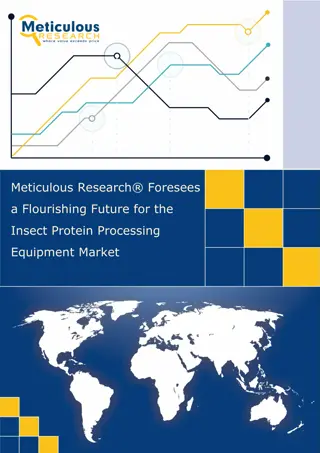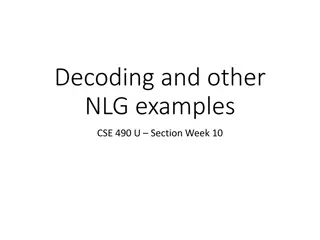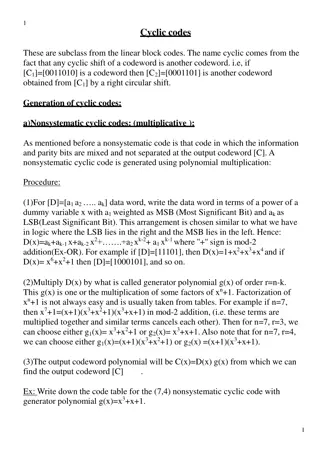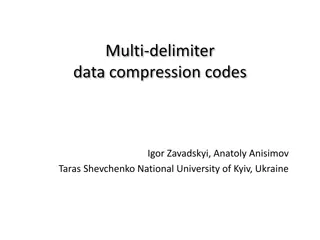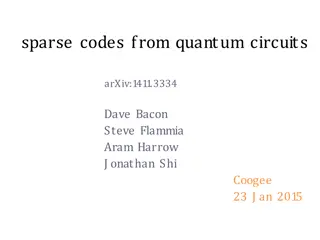Decoding the Hidden Regulatory Codes Shaping Protein Evolution
The study explores the intricate relationship between genetic and regulatory codes that shape protein evolution. Discusses how duons, genomic footprints, and transcription factors densely populate and constrain protein-coding exons. Highlights how regulatory elements influence codon choice independently of protein structure. The significance of dual-use codons (duons) that specify amino acids and transcription factor recognition sites is elucidated. Genomic footprint analysis and the impact of genetic variation on transcription factor occupancy are also covered.
Uploaded on Sep 20, 2024 | 0 Views
Download Presentation

Please find below an Image/Link to download the presentation.
The content on the website is provided AS IS for your information and personal use only. It may not be sold, licensed, or shared on other websites without obtaining consent from the author. Download presentation by click this link. If you encounter any issues during the download, it is possible that the publisher has removed the file from their server.
E N D
Presentation Transcript
The Hidden Codes That Shape Protein Evolution ----Exons Binding Transcription Factor Speaker: HU Xue-Jia Supervisor: WU Yun-Dong Date: 19/12/2013
Contents Introduction Regulatory codes Duons Genomic footprint TFs densely populate and evolutionarily constrain protein-coding exons TFs modulate global codon biases Genetic variation in duons frequently alters TF occupancy Summary and perspective 2
Contents Introduction Regulatory codes Duons Genomic footprint TFs densely populate and evolutionarily constrain protein-coding exons TFs modulate global codon biases Genetic variation in duons frequently alters TF occupancy Summary and perspective 3
Regulatory codes Despite redundancy in the genetic code, the choice of codons used is highly biased in some proteins, suggesting that additional constraints operate in certain protein-coding regions of the genome. There are many kinds of regulatory elements within protein coding regions (such as transcription factor binding) those can influence codon choice and amino acid preference that are independent of protein structure or function. Weatheritt, R J.; Badu, M M. Sceicne. 2013, 342: 1325-1326. 4
Duons The genetic and regulatory codes have been assumed to operate independently of one another and to be segregated physically into the coding and noncoding genomic compartments. The potential for some coding exons to accommodate transcriptional enhancers or splicing signals has long been recognized. Duons : dual-use codons (simultaneously specify both amino acids and TF recognition sites) TF: transcription factor Stergachis, A J.; et al. Sceicne. 2013, 342: 1367-1372. 5
Genomic footprint A method of investigating the sequence specificity of DNA- binding proteins in vitro. This technique can be used to study protein-DNA interactions both outside and within cells. 6
Contents Introduction Regulatory codes Duons Genomic footprint TFs densely populate and evolutionarily constrain protein-coding exons TFs modulate global codon biases Genetic variation in duons frequently alters TF occupancy Summary and perspective 7
The abundance of TFs Method: deoxyribonuclease (DNase ) footprinting Materials: 81 diverse cell types (human gnome) Approximately 14% of all human coding bases contact a TF in at least one cell type (average 1.1% per cell type), 86.9% of genes contained coding TF footprints (average 33% per cell type) The density of TF footprints at different genic positions varied widely. 8
Evolutionary constraint at coding footprint SNV: single nucleotide variation Both synonymous and nonsynonymous mutations within coding footprints were significantly younger than those outside of footprints. Estimated mutational age at all (gray), synonymous (brown), and nonsynonymous (red) coding SNVs within and outside footprints. 9
TFs influence codon and amino acid choice Fourfold-degenerate bases: A position of a codon is said to be a fourfold degenerate site if any nucleotide at this position specifies the same amino acid. TFs constrain both codon choice (via constraint on 4FDBs) and amino acid choice (via NDBs) encoded at their recognition sites. 10
Contents Introduction Regulatory codes Duons Genomic footprint TFs densely populate and evolutionarily constrain protein-coding exons TFs modulate global codon biases Genetic variation in duons frequently alters TF occupancy Summary and perspective 11
TFs modulate global codon biases For all amino acids encoded by two or more codons the codon that is preferentially used genome-wide is preferentially occupied by TFs. The third position of preferred codons overlapping footprints is under excess evolutionary constraint supports a general role for TFs in potentiating codon usage biases through the selective preservation of preferred codons. 12
Contents Introduction Regulatory codes Duons Genomic footprint TFs densely populate and evolutionarily constrain protein-coding exons TFs modulate global codon biases Genetic variation in duons frequently alters TF occupancy Summary and perspective 13
SVNs affect TF occupancy 3% of coding footprints harbored heterozygous SNVs. 17.4% quantitatively skew the allelic origins of DNA fragments protected from cleavage by DNase in human cells, suggesting that such SNVs affect TF occupancy. 14
Influence of SNVs in duons Proportion of SNVs in duons that allelically alter TF occupancy Such SNVs (mentioned before) are not biased toward whether they result in synonymous or nonsynonymous changes. Intriguingly, a large fraction of nonsynonymous variants are predicted not to alter protein function. This indicates that some variants within duons might primarily affect transcription factor binding instead. This supports the emerging idea that SNVs within protein-coding regions can lead to disease without affecting protein structure or function. 15 Weatheritt, R J.; Badu, M M. Sceicne. 2013, 342: 1325-1326.
Contents Introduction Regulatory codes Duons Genomic footprint TFs densely populate and evolutionarily constrain protein-coding exons TFs modulate global codon biases Genetic variation in duons frequently alters TF occupancy Summary and perspective 16
Summary and perspective ~14% regions called duons of the codons encode two types of information. The requirement for transcription factors to bind within protein-coding regions of the genome has led to a considerable bias in codon usage and choice of amino acids, in a manner that is constrained by the binding motif of each transcription factor. TFs modulate global codon biases 17.4% quantitatively SNVs those skew the allelic origins of DNA fragments affect transcription factor occupancy. Some SNVs within duons might primarily affect transcription factor binding instead. This supports the emerging idea that single-nucleotide variants within protein-coding regions can lead to disease without affecting protein structure or function. It is unclear how the binding of a TF within protein-coding regions mechanistically influences the expression of a gene. It is also unclear whether binding of a TF within a protein-coding region may not directly affect gene expression but instead determine the formation and maintenance of higher-order chromatin structure. 17
Method: deoxyribonuclease (DNase) footprinting Materials: 81 diverse cell types (human gnome) Stergachis, A J.; et al. Sceicne. 2013, 342: 1367-1372. 19
A subset of TFs selectively avoid coding sequences. TFs involved in positioning the transcriptional preinitiation complex, such as NFYA and SP1, preferentially avoid the translated region of the first coding exon and typically occupy elements immediately upstream of the methionine start codon. Conversely, TFs involved in modulating promoter activity, such as YY1 and NRSF, preferentially occupy the translated region of the first coding exon (Fig. 3, A and C) (30, 31). These findings indicate that the translated portion of the first coding exon may serve functionally as an extension of the canonical promoter. 20





